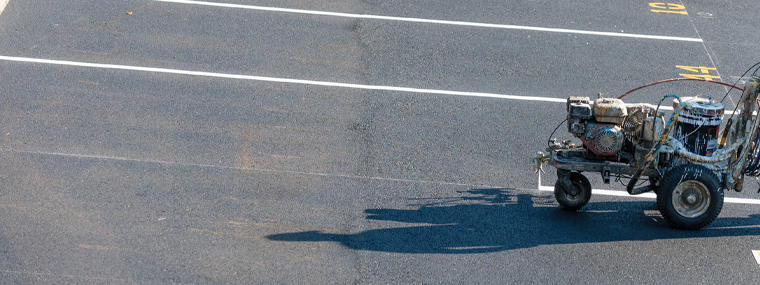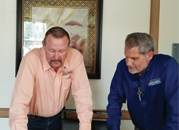
Parking Lot Restriping and Seal Coating
What You Need to Know
By ACPLM Inc. / Published June 2020

Asphalt Questions from HOA Communities
Your parking lot makes the first impression when people show up at your community. For this reason, it is important to maintain the look of your property to preserve the value of your community.
Asphalt paving is a critical facet of a structured and organized parking lot. Yet, as time goes by, the condition of the sealant or paint on the driveway may start to fade and wear away, making it look old or dirty.
Asphalt maintenance not only serves the purpose of alleviating safety concerns but also enhances the aesthetics of your property and community.
So, what do you need to know about parking lot restriping? Let’s look at some common questions.
What is asphalt pavement?
Also known as HOT Mix, asphalt pavement is a combination of two primary materials: a molten liquid asphalt component (the black binder) and crushed rock or aggregate. The combined ingredients are then compacted to form asphalt pavement.
Why does asphalt pavement deteriorate?
Over time, the amount of traffic, harsh environmental conditions, and the quality of the paint may ultimately lead to failure of the pavement. When left untreated, asphalt will deteriorate rapidly.
The asphalt binder (the glue that bonds the pavement together) usually starts to oxidize and weather over time, allowing moisture to penetrate the asphalt and cause damage to the pavement subbase.
Other significant concerns for parking lot maintenance include oil, gas, and salt—these cause further substantial damage to the pavement surface.
Without proper asphalt maintenance, the asphalt pavement undergoes environmental distress, transforming from a freshly laid black appearance to a drab, old, and oxidized gray appearance.
[adrotate group=”1″]
How often should you re-stripe your parking lot?
Under ordinary circumstances, you should re-stripe your parking lot every two years. Or, once it diminishes below 75 percent of its original look, you can make the necessary arrangements to have the parking lot restriped.
How do contractors apply sealant on an asphalt driveway?
Striping over freshly laid asphalt or sealer requires the use of a water-borne coating. Often, a contractor will utilize set-fast acrylic water-borne paint for restriping. Even so, the contractor must apply the surface coat at ideal temperatures above 45 degrees Fahrenheit.
This step entails the use of an airless striping machine set at a minimum gauge of 13 mils wet coating thickness, thus ensuring high-quality lot markings. Be sure to include textured grit in the paint to avoid a slippery painted surface during inclement weather.
Because some of the paint is likely to soak into the asphalt and result in a thinner look, applying two thin coats instead of a single thick layer is a smart approach. Also, this helps curb the frequent issue of too much paint build-up.
Typically, drying time takes approximately 30 minutes. But here’s the caveat; you’ll have to keep traffic off the lot for a minimum of one to two hours.
What compliance requirements should you know about regarding parking lot restriping?
Before you begin the lot marking process, make sure that your parking lot complies with the stipulations of Americans with Disabilities Act (ADA). These standards include verifying that your property adheres to the minimum number of accessible stalls—taking into account the dimensions of the parking lot.
Let’s say your parking lot fails to meet the above asphalt maintenance guidelines; what’s next? Apart from having the option of reconfiguring the spaces to a suitable number by repainting the stripes, you can also design a new parking layout.
What are the benefits of restriping your parking lot?
Aesthetics—This attribute is one of the important reasons you should restripe your parking lot. A restriped lot or drive will enhance the appearance of your investment.
Organization—This helps your guests know the designated parking spots—guiding your visitors on where to park correctly. It also enhances the flow of vehicular traffic.
Compliance—The ADA Act provides the guidelines for parking lot striping, crosswalks, and ramps. Based on the number of available parking spaces and car dimensions, striping makes it possible to clearly assign spots so that you comply with the legal requirements.
Maximize Parking Space—Capitalize on striping to exploit the full potential of your parking lot. Here, you can leverage the expertise of an asphalt company to help you evaluate the space and suggest suitable changes.
Liability—Faded lines are challenging to see, and this concern could potentially result in mishaps where you could be culpable. This is more so because the lines pass on information indicating where pedestrians should walk, which subject has the right of way, which areas to avoid, and where vehicles should stop. While faded lines may cause confusion and subsequent accidents, visible, clearly defined lines will lower your liability risk.
Compliance with Fire Code Guidelines—As a provision for an emergency, fire codes demand a designated fire lane. It is a requirement to distinctly mark this lane with the appropriate signs, curb stickers/signage, or pavement markings.
Is asphalt seal coating a smart choice for pavement preservation?
An asphalt pavement is primarily rock, gravel, and a binder. Preserving the asphalt is an essential factor of asphalt maintenance—and results in prolonging the service life of asphalt pavement surfaces. Besides rain and UV ray issues, several other chemicals are introduced into the asphalt (especially during winter), degrading the binder and hence accelerating the need for asphalt repair.
Asphalt sealing not only curbs the concern of the surface turning brittle, but equally protects the asphalt pavement from environmental elements while also beautifying the driveway.
Why should you include a seal coating program in your parking lot asphalt maintenance budget?
Seal coating provides an extra layer of protection, shielding against harmful intrusions of the adverse elements mentioned above. Furthermore, when the seal coating contractor applies the asphalt sealant according to the manufacturers’ recommendations, this will extend the lifespan of the pavement surface.
Asphalt sealers are commonly bituminous-based products. Seal coating equates to a liquid formulation consisting of the stated emulsions and a combination of water, silica, and polymer additives alongside other property fillers and solids. During the seal coat process, these products are applied either by brush, spray, or squeegee.
In a nutshell, when you regularly schedule seal coating as part of your asphalt maintenance, you’ll significantly reduce the cost of having to repair or replace the pavement.
Jim Fernandez and Tom Fairfax
Owners, Asphalt and Concrete Parking Lot Maintenance (ACPLM)
When Jim Fernandez and Tom Fairfax decided to create Asphalt and Concrete Parking Lot Maintenance (ACPLM), they understood the importance of maintaining a reputation of trust, commitment, and integrity. Since ACPLM was founded in 2012, it has completed more than 2,400 jobs ranging from asphalt and concrete repair to striping and seal coating, with representatives ensuring every job is quality workmanship. Their combined experience of more than 50 years in the field of parking lot maintenance and dedication to their clients proved to be the solid foundation they needed in order to make ACPLM into the success it is today.
For more information, visit www.acplm.net.







